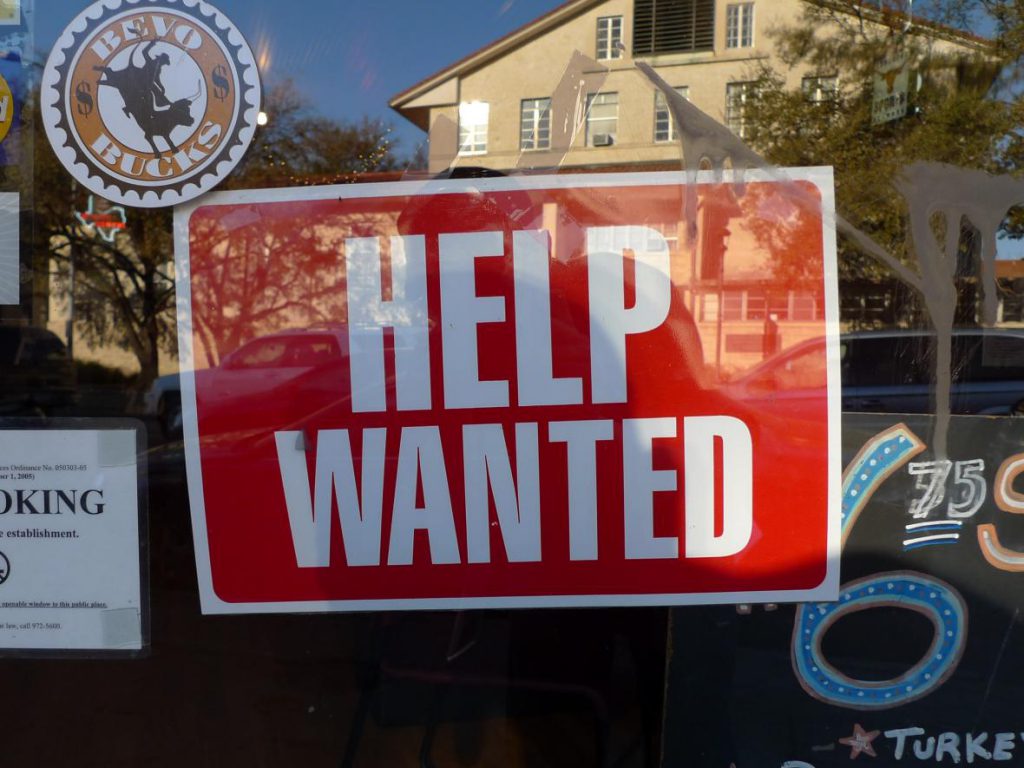6 Ways to Measure State of Workers
The data shows some surprising improvements in Wisconsin employment picture.

Help Wanted. Photo by Andreas Klinke Johannsen (CC BY-SA 2.0)
One day after Labor Day, what does the state stand when it comes to Wisconsin’s workers? The numbers are cited almost daily by Capitol politicians in the “glass half full/half empty” debate on the state’s economic recovery. Here are six ways to measure this. You be the judge.
1. The statewide unemployment rate was 3.9% in July, lower than the national rate of 5.4%, according to the state Department of Workforce Development (DWD). “Wisconsin’s job numbers continue to show growth despite the Delta Variant’s emergence,” said DWD Secretary-designee Amy Pechacek, citing the 13,000 non-farm jobs created in one month.
But the annual “Working Wisconsin” report, compiled by UW-Madison’s Center on Wisconsin Strategy (COWS), said the state’s net job loss, compared to pre-Covid 19 levels, was 114,000. “In July, some 121.500 Wisconsinites were looking for work,” COWS reported. “July unemployment slightly exceeds [pre-Covid] 3.5% unemployment.”
2. The jobless rates fell in cities: DWD said July jobless rates in Wisconsin cities ranged from a low of 3.1% in Madison to a high of 7.1% in Milwaukee. Those improved from July 2020 jobless rates of 6.1% in Madison and 11.7% in Milwaukee, DWD reported.
The numbers were not seasonally adjusted.
DWD also listed these other one-year drops in unemployment rates: Beloit, 7.1% in July 2021 compared to 9.4% in July 2020; Janesville, 4.9% and 8.9%; Green Bay, 4.2% and 8.3%, Racine, 7.3% and 10.3%, and Kenosha, 5.5% and 8.9%. All saw significant drops in the unemployment rate.
But Wisconsin’s leisure and hospitality industry was hit hardest and had a net loss of 49,600 jobs statewide, according to COWS. “Even before the collapse, the industry’s workforce of waitstaff, bartenders, dishwashers, housekeepers, and others suffered low-wages, volatile and unpredictable hours, and few benefits,” COWS reported, adding that they were “more likely to be women and people of color.”
“In April 2020, at the depth of the crisis, more than half of workers in this industry lost their jobs. The industry has been moving slowly out of that hole since collapse, though there has been volatility…. The industry remains 17.6% below pre-COVID-19 employment levels.”
3. Labor participation rate: DWD reported that 66.4% of potential workers were in the labor force in July — 4.7 percentage points higher than the national rate.
Yet the state’s official motto — “Forward” — has been unofficially replaced by the “Now Hiring” signs outside many businesses across the state. Wisconsin must do more to “attract and retain talent,” Kurt Bauer, president of Wisconsin Manufacturers and Commerce said in July. “We must reinstate the talent attraction campaign to show off our state’s high quality of life and invest further in preparing our next generation for the family-supporting careers we have in Wisconsin.”
4. Recent wage growth was “especially strong”: Wage growth was much stronger in the last two years, COWS found. The 2020 median wage was $20.24 per hour – a jump of $1.50 in two years, for example.
5. Still ”substantial” wage inequality: “In 2020, the hourly median wage for white men — $22.86 – was the highest,” COWS found, adding: “White women had the second highest median, $19.03, 17% below the white men’s median. Hispanic men, median of $17.51, have the next highest median; 23% lower than white men. Black women with a $16.64 median, face a 27% deficit. Median wages for Hispanic women ($16.04) and Black men ($15.94) are 30% lower than white men’s wages.”
6. Recent wage growth “closed” some racial, ethnic disparities: “The state’s ethnic and racial wage gaps remain substantial, but they have diminished slightly over the last two years,” COWS reported.
“The two groups with the slowest wage gains across the last two years are white women (up 7%) and white men (up 3%).”
The COWS summary of Wisconsin’s Labor Day 2021: “There are now reasons for optimism…. Vaccinations are widely available. Federal investments in recovery are supporting families and children. Still, the Delta Variant is on the rise, and some of the programs that support the most vulnerable [will] end.
“For working Wisconsin, there’s no crystal ball about where we’ll be in a few months.”
Steven Walters started covering the Capitol in 1988. Contact him at stevenscotwalters@gmail.com
If you think stories like this are important, become a member of Urban Milwaukee and help support real, independent journalism. Plus you get some cool added benefits.
The State of Politics
-
A Wisconsin Political Trivia Quiz
 Dec 15th, 2025 by Steven Walters
Dec 15th, 2025 by Steven Walters
-
The Fight Over Wisconsin’s House Districts
 Dec 8th, 2025 by Steven Walters
Dec 8th, 2025 by Steven Walters
-
The Battle Over On-Line Betting
 Nov 24th, 2025 by Steven Walters
Nov 24th, 2025 by Steven Walters





















